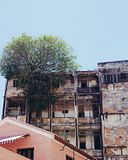 This blue crepe-back satin was purchased three or four years ago, for the purpose of making a new corset. I've always wanted a blue one, but you can see how my aversion to making them put this off for so long! I had to wade through a mound of fabric to find this, but I was glad when I did. It is darker than the original, but I like the cornflower color a little bit better.
This blue crepe-back satin was purchased three or four years ago, for the purpose of making a new corset. I've always wanted a blue one, but you can see how my aversion to making them put this off for so long! I had to wade through a mound of fabric to find this, but I was glad when I did. It is darker than the original, but I like the cornflower color a little bit better. I decided to use the Laughing Moon Mercantile Undergarment Pattern; my previous corset was the Silverado, but I decided to try the Dore corset instead. Little did I know that in the ensuing six years, the uncut pattern pieces for the Dore had disappeared! Thus began my odyssey: the first drafted corset. I had only the two front pattern pieces for the Dore pattern, so I cut them out, and then looked at the pattern instructions. Using the picture of the other pieces as a guide of the basic shape, my knowledge of corsetry, and my original corset, I drew out the pattern on my twill:
I decided to use the Laughing Moon Mercantile Undergarment Pattern; my previous corset was the Silverado, but I decided to try the Dore corset instead. Little did I know that in the ensuing six years, the uncut pattern pieces for the Dore had disappeared! Thus began my odyssey: the first drafted corset. I had only the two front pattern pieces for the Dore pattern, so I cut them out, and then looked at the pattern instructions. Using the picture of the other pieces as a guide of the basic shape, my knowledge of corsetry, and my original corset, I drew out the pattern on my twill: I did make a few mistakes. In order to do a tighter waist-lacing, the hips need to be fuller than I have them here; unfortunately, I didn't realize this until the whole thing was constructed and on! However, for my first attempt, pulling the pattern basically out of my ass, I'm rather proud of myself;)
I did make a few mistakes. In order to do a tighter waist-lacing, the hips need to be fuller than I have them here; unfortunately, I didn't realize this until the whole thing was constructed and on! However, for my first attempt, pulling the pattern basically out of my ass, I'm rather proud of myself;) Next came those distinctive fold-over pleats that the historical one has. These were a major pain, and I should have omitted them, but what can you do? I cut my four front satin pieces extra long, keeping the twill interlining the correct shape, and then pinned the pleats and ironed them, turning the pleats down at the center front and up at the bust seam. I tried my best to match them so the pleats would meet, but something happened in construction to make them slightly askew. D'oh!
Next came those distinctive fold-over pleats that the historical one has. These were a major pain, and I should have omitted them, but what can you do? I cut my four front satin pieces extra long, keeping the twill interlining the correct shape, and then pinned the pleats and ironed them, turning the pleats down at the center front and up at the bust seam. I tried my best to match them so the pleats would meet, but something happened in construction to make them slightly askew. D'oh!
Once the pleats were all pinned, I proceeded to sew the satin and interlining pieces together, treating each matching satin and interlining pieces as one piece, flat-lining the top layer, basically. The lining was sewn together as well, and a piece of petersham was sewn on the wrong side of the lining to serve as the waistband. Then, I prepared my top layer to receive the busk.
There are lots of different techniques for this, and I'm sure different corset makers will have different methods, but I always mark out where the busk must come through the fabric and make button-holes for the hooks and knobs to poke through. Once they're complete, I sew the front and lining together at the center-front and center-back seams and turn the two sides of the corset right-side out. Then I insert the busk into each side and sew a pocket to hold it in place, as close to the busk as possible so it doesn't shift at all.
 Next, I top-stitched a seam down each seam in the corset, sewing the lining and top-fabric together. Another seam goes next to these, to create the bone channels. Most Victorian corsets take 1/4" white and spiral bones, and the presser foot on your machine is a good guide for how wide the channels need to be. I sewed a seam at the bottom to close the channels off, and inserted my bones. The back two channels, placed on either side of the grommets, are white steel, and the rest are spiral, for flexibility. Once the bones are in place, I sewed the top seam to close them off.
Next, I top-stitched a seam down each seam in the corset, sewing the lining and top-fabric together. Another seam goes next to these, to create the bone channels. Most Victorian corsets take 1/4" white and spiral bones, and the presser foot on your machine is a good guide for how wide the channels need to be. I sewed a seam at the bottom to close the channels off, and inserted my bones. The back two channels, placed on either side of the grommets, are white steel, and the rest are spiral, for flexibility. Once the bones are in place, I sewed the top seam to close them off.
 Next, I cut bias strips of fabric and sewed them to the top and bottom of the corset, folding them over in the back and slip-stitching them into place, to give the corset a nice, finished look. I marked my grommets and set them at this time as well.
Next, I cut bias strips of fabric and sewed them to the top and bottom of the corset, folding them over in the back and slip-stitching them into place, to give the corset a nice, finished look. I marked my grommets and set them at this time as well.
 Finally, I sewed the trim and did the embroidery. In this case, I used two ecru cotton laces, layered over one another. The bottom lace had a definite edge, which I liked, but no space for threading ribbon into it, so I put a thinner threading-lace over it, and put a baby blue single-face satin ribbon through it for some color. At the bottom of the bone channels I embroidered a simple cross-over x, which you find so often in period corsets, to reinforce the ends of the bones. Then, I laced myself in and tightened, and discovered that the hips were a little narrow and the pleats had shifted! Oh, well. It was only 11 hours worth of work, after all. Next time, I'll know better!
Finally, I sewed the trim and did the embroidery. In this case, I used two ecru cotton laces, layered over one another. The bottom lace had a definite edge, which I liked, but no space for threading ribbon into it, so I put a thinner threading-lace over it, and put a baby blue single-face satin ribbon through it for some color. At the bottom of the bone channels I embroidered a simple cross-over x, which you find so often in period corsets, to reinforce the ends of the bones. Then, I laced myself in and tightened, and discovered that the hips were a little narrow and the pleats had shifted! Oh, well. It was only 11 hours worth of work, after all. Next time, I'll know better!
 Next, I top-stitched a seam down each seam in the corset, sewing the lining and top-fabric together. Another seam goes next to these, to create the bone channels. Most Victorian corsets take 1/4" white and spiral bones, and the presser foot on your machine is a good guide for how wide the channels need to be. I sewed a seam at the bottom to close the channels off, and inserted my bones. The back two channels, placed on either side of the grommets, are white steel, and the rest are spiral, for flexibility. Once the bones are in place, I sewed the top seam to close them off.
Next, I top-stitched a seam down each seam in the corset, sewing the lining and top-fabric together. Another seam goes next to these, to create the bone channels. Most Victorian corsets take 1/4" white and spiral bones, and the presser foot on your machine is a good guide for how wide the channels need to be. I sewed a seam at the bottom to close the channels off, and inserted my bones. The back two channels, placed on either side of the grommets, are white steel, and the rest are spiral, for flexibility. Once the bones are in place, I sewed the top seam to close them off. Next, I cut bias strips of fabric and sewed them to the top and bottom of the corset, folding them over in the back and slip-stitching them into place, to give the corset a nice, finished look. I marked my grommets and set them at this time as well.
Next, I cut bias strips of fabric and sewed them to the top and bottom of the corset, folding them over in the back and slip-stitching them into place, to give the corset a nice, finished look. I marked my grommets and set them at this time as well. Finally, I sewed the trim and did the embroidery. In this case, I used two ecru cotton laces, layered over one another. The bottom lace had a definite edge, which I liked, but no space for threading ribbon into it, so I put a thinner threading-lace over it, and put a baby blue single-face satin ribbon through it for some color. At the bottom of the bone channels I embroidered a simple cross-over x, which you find so often in period corsets, to reinforce the ends of the bones. Then, I laced myself in and tightened, and discovered that the hips were a little narrow and the pleats had shifted! Oh, well. It was only 11 hours worth of work, after all. Next time, I'll know better!
Finally, I sewed the trim and did the embroidery. In this case, I used two ecru cotton laces, layered over one another. The bottom lace had a definite edge, which I liked, but no space for threading ribbon into it, so I put a thinner threading-lace over it, and put a baby blue single-face satin ribbon through it for some color. At the bottom of the bone channels I embroidered a simple cross-over x, which you find so often in period corsets, to reinforce the ends of the bones. Then, I laced myself in and tightened, and discovered that the hips were a little narrow and the pleats had shifted! Oh, well. It was only 11 hours worth of work, after all. Next time, I'll know better!My sister's first words? "Now I want a new corset . . . "
Yeah. Next year, Tab. Next year.

































No comments:
Post a Comment